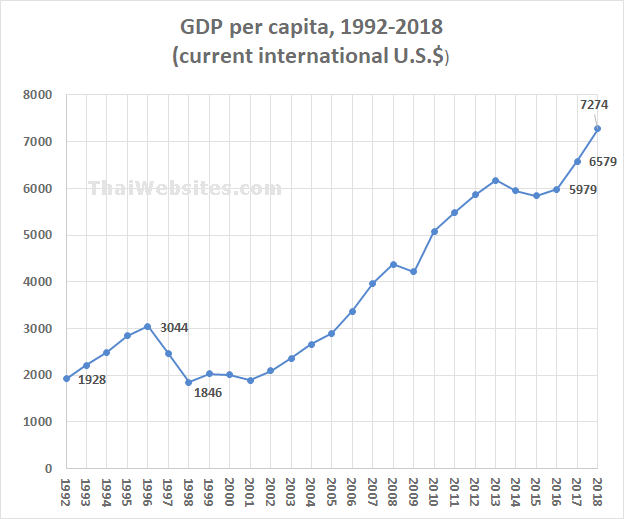Health, Economic Status and Poverty
- tdela010

- Sep 20, 2020
- 4 min read
Updated: Nov 25, 2020

(Retrieved from https://www.thaiwebsites.com/thailand-GDP.asp )
Economic Overview
As we can see from the graph above, Thailand has made consistent gains in GDP growth over the past 25 years. Thailand is one of the great development success stories; moving from a low-income to an upper-income country in less than a generation. It has used smart economic policies that have resulted in its "upper middle income economy" (The World Bank, 2020). As seen in the graph below, GNI per capita, PPP (current international $) in Thailand was reported at 18520 USD in 2019 (The World Bank, 2020).

How do these indicators compare to the United States?
GDP (Knoema, 2020):
Thailand: $529.18 billion in 2019
United States: $21,439.45 billion in 2019
GDP spent of Health Care (Knoema, 2020):
Thailand: 3.7 % in 2017
United States: 17.1% in 2017
GNI per capita PPP (Population Reference Bureau, 2020):
Thailand: $17,650
United States: $63,780
These statistics revel the large gulf between countries. The United States has a significantly richer population and spends billions more as a country. From these statistics, one would assume the US would have significantly better health indicators, but that is not the case. See Health Indicators blog post.
COVID19:
Unfortunately, the economic impact has been severe and threatens the reduction of poverty that we've seen over the past decade . Even though Thailand has been successful at slowing the spread of COVID19, the pandemic has led to widespread job losses. This is affecting middle-class households and the poor alike (The World Bank, 2020). See graph below.

(Retrieved from https://www.nationthailand.com/business/30390530?utm_source=homepage&utm_medium=internal_referral)
The Thai economy is expected to contract in 2020 , which is among the sharpest projected declines in the East Asia/Pacific region. This is due to a decline in external demand affecting trade and tourism, supply chain disruptions and weakening domestic consumption. The government has quickly responded with a fiscal package (6% of GDP) to support vulnerable people (The World Bank, 2020). The projections, though, still remain poor (see below).

(Retrieved from https://asia.nikkei.com/Editor-s-Picks/Interview/World-Bank-warns-of-third-shock-after-coronavirus-and-trade-war2)
Poverty:
Over the last 30 years, poverty rates dropped from 65.2% in 1988 to 9.85% in 2018. However, the growth of household incomes and consumption have stalled in recent years. This has resulted in the rise of poverty. Between 2015 and 2018, the poverty rate in Thailand increased from 7.2% to 9.8%, and the number of people living in poverty rose from 4.85 million to more than 6.7 million. The increase in poverty in 2018 occurred in all regions and in 61 out of 77 provinces. In Central and Northeast Thailand, the number of the poor increased by over half a million in each region during the same period. The South became the region with the highest poverty rate for the first time in 2017 (The World Bank, 2020).
Inequality:
Inequality has been increasing. The average household consumption per capita has grown, but the household consumption of the bottom 40% of the population has lessened (The World Bank, 2020).

(Retrieved from https://www.aseantoday.com/2019/01/thailands-wealth-inequality-is-the-highest-in-the-world-what-does-this-mean-for-upcoming-elections/)

(Retrieved from https://www.aseantoday.com/2019/01/thailands-wealth-inequality-is-the-highest-in-the-world-what-does-this-mean-for-upcoming-elections/)
The bottom 10% of Thais hold 0% of the wealth, being either in debt or having no documented household income. The poorest 50% of Thais now hold only 1.7% of the country’s wealth, while the richest 10% now hold 85.7% (Asean Today, 2019).
Thailand's rapid economic growth has brought pieces of the population out of poverty but provided disproportionate benefits to the wealthy. While Thailand’s (GDP) per capita tripled between 1980 and 1995, spending on social services remained stagnant, preventing lower classes from taking advantage of the growth. Today, Thailand only spends 7.8% of its GDP on social services, according to the Thailand Development Research Institute, while most developed nations spend an average of 20% (Asean Today, 2019).
What Does This Mean for Health?

A child wears a mask in Thailand slum. The World Bank's forecast of a "third shock" could devastate economic growth and increase poverty across developing Asia. (Photo by Akira Kodaka) . (Retrieved from https://asia.nikkei.com/Editor-s-Picks/Interview/World-Bank-warns-of-third-shock-after-coronavirus-and-trade-war2)
Healthcare Expenditure and Health Outcomes:
There is a significant relationship between public health expenditure and health outcomes (Skolnik, 2020). Evidence of this relationship is found in an analysis conducted by using the World Bank data set for 15 countries over a 20-year period (1995–2014) (Rahman n.d, 2018). "Relevant fixed and random effect models were estimated to determine the effects of healthcare expenditure on health outcomes. Total health expenditure, public health expenditure and private health expenditure significantly reduced infant mortality rates, and, the extent of effect of private health expenditure was greater than that of public health expenditure. Private health expenditure also had a significant role in reducing the crude death rate. Per capita income growth and improved sanitation facilities also had significant positive roles in improving population health in the region" (Rahman, 2018).
Relationship between health and productivity:
According to Skolnik our health is "strongly associated with productivity and earnings". Healthier people are able to work harder, work more hours, and work over a longer span of years than can those who aren't as healthy (Skolnik, 2020).
References
Asian Today. (2019). Thailand’s wealth inequality is the highest in the world: What will this mean for the upcoming elections? Retrieved from https://www.aseantoday.com/2019/01/thailands-wealth-inequality-is-the-highest-in-the-world-what-does-this-mean-for-upcoming-elections/
Knoema. (2017). Health Expenditure. Retrieved from https://knoema.com/atlas/Thailand/topics/Health/Health-Expenditure/Health-expenditure-as-a-share-of-GDP
Nikkei Asian Review. (2020). World Bank warns of 'third shock' after coronavirus and trade war. Retrieved from https://asia.nikkei.com/Editor-s-Picks/Interview/World-Bank-warns-of-third-shock-after-coronavirus-and-trade-war2)
The Nation Thailand. (2020). Thai economy to shrink 5% as Covid-19 hammers households, firms, tourism. Retrieved from https://www.nationthailand.com/business/30390530?utm_source=homepage&utm_medium=internal_referral
Population Reference Bureau. (2020). Retrieved from https://www.prb.org/international/indicator/gross-national-income/map/country
Rahman, M.M., Khanam, R. & Rahman, M.(2018). Health care expenditure and health outcome nexus: new evidence from the SAARC-ASEAN region. Global Health 14, 113 (2018). Retrieved from https://globalizationandhealth.biomedcentral.com/articles/10.1186/s12992-018-0430-1
Skolnik, Richard. (2020). Global Health 101 (4th ed.). Burlington, MA: Jones & Bartlett
The World Bank. (2020). The World Bank In Thailand. Retrieved from https://www.worldbank.org/en/country/thailand/overview



Comments